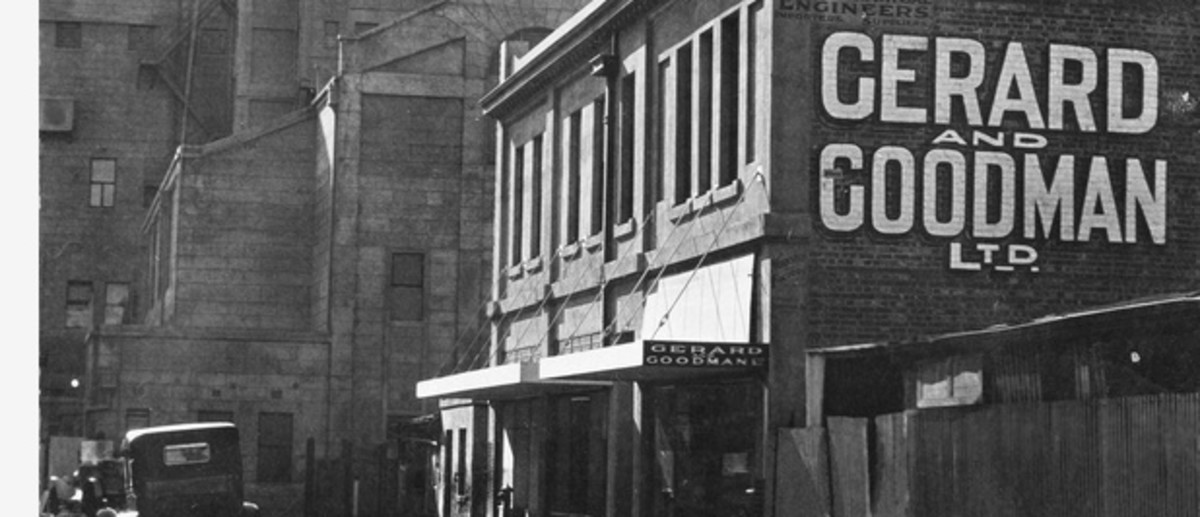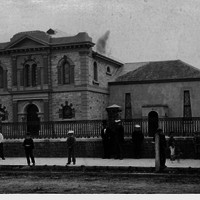Synagogue Place, named after the Synagogue built in 1850, has been the centre of the Jewish community in South Australia for much of the nineteenth and twentieth centuries. It has since grown, becoming increasingly commercialised with numerous businesses making it their home.
The Jewish Community of Adelaide
There has been a Jewish community in South Australia since the first year of European colonisation in 1836. The community was initially small with around 50 members in 1848, however, it steadily grew during the nineteenth century to a population of 360 people by 1860. They arrived in the colony via ship from England, while others travelled from other Australian colonies, such as New South Wales. Their cultural origins, however, traced back to central and eastern Europe, specifically Germany and Poland. The cultural composition of the Adelaide Jewish community would remain dominated by those of German and Polish origin for more than a century, despite the fact that many English Jews had Mediterranean origins.
Once they had arrived in Adelaide many in the Jewish community went into business, living near the business district in the centre of Adelaide and often above their place of business, while others in the community went into politics, with four Jewish Mayors and seven members of parliament serving from the 1850s to the 1920s. Notable of which was Sir Lewis Cohen, who was elected five times. While they assimilated into the new colony, the Jewish community also maintained their identity and cultural cohesion through the establishment of religious organisations, such as the Adelaide Hebrew Philanthropic Society that was founded in 1852, and the Adelaide Hebrew Congregation, founded in 1848. The philanthropic society looked after and maintained links among members of the Jewish community, while the Adelaide Hebrew Congregation set about establishing a permanent place of worship.
Synagogue Place
The location for the first synagogue in South Australia was selected by the Adelaide Hebrew Congregation, off of Rundle Street, on the street that would later be named Synagogue Place. The land fronting Rundle Street was bought from George Morphett for £280 in 1848, with the synagogue completed two years later in August 1850. The building was small, 35 by 25 feet, and had a capacity for 150 worshipers. It was made of stone and of an 'Egyptian' style, which was popular among Jewish populations in Australia during the nineteenth century. This style, reminiscent of ancient temples and sygnifying the ancient origins of Judaism, made the synagogue stand out from the surrounding buildings. The interior of the synagogue featured a partially screened women's gallery, polished cedar pews and bronze chandeliers, and was described by The South Australian Register in 1850 as 'handsome, appropriate, and strongly demonstrative of the liberal spirit which characterises the Jewish community in this province.' The combined costs of buying and building the synagogue were reportedly £950. This was raised by the Adelaide Hebrew Congregation through loans and donations from both the Jewish and wider Christian communities.
The synagogue, however, became inadequate within ten years of its establishment, as the Jewish community in Adelaide outgrew its capacity. Extensions were added in 1859 and 1860, with additional meeting chambers constructed adjacent to the synagogue and an extension added to the women's gallery. However, these were not sufficient enough to meet the needs of the community, with thoughts of building a new synagogue already being entertained. In May 1870 it was decided to build on the existing site next to the original synagogue. The new synagogue was designed by South Australian architects Edmund Wright, Edward Woods and Edward Hamilton in an ‘Italian’ style, which drew influences from the architecture of the Italian renaissance. This stone building had a capacity for 370 people, dwarfing the adjacent 1850 synagogue that was converted into a classroom. This substantial building cost £1,065 and consolidated the position of the Jewish community in South Australia. The entrance to this building originally faced Rundle Street and featured a lawn and fountain leading up to it. However, the construction of the Rundle Buildings on the corner of Rundle Street and Synagogue Place during the building boom of the 1890s forced the entrance of the synagogue to move to its current location in Synagogue Place.
Further changes were made to the building in 1938, with both the synagogue and Rundle Buildings receiving a new Art Deco cement facade designed by architect Chris A. Smith. This remodeling scheme also extended the building to the footpath and included the addition of an entrance porch containing a memorial tablet to Jewish soldiers who died during the First World War. The synagogue building has been altered little since these renovations.
Synagogue Place remained the centre of the Jewish community in South Australia until they relocated in 1990 to a new synagogue in Glenside. The original synagogue building has since become a nightclub.
Businesses and Retailers in Synagogue place
The buildings surrounding the synagogue in Synagogue Place have become increasingly commercialised since the 1920s, as cottages were demolished to make way for stores and
Gerard and Goodman
Most notable of the businesses in Synagogue Place was Gerard and Goodman. The electrical merchandising company, started by Alfred Gerard in 1907, grew into a major electronic accessory manufacturer, importer and retailer. As the company grew, land was bought in Synagogue Place for a showroom, factory and offices. Initially a two-storey building was erected in 1921-1922, with the company moving into the premises in 1923. This building saw multiple additions over the years as the company expanded to meet the demand for electrical goods during the interwar years. The first of these additions was in 1925 when two shops and an adjoining first floor were added. These housed shops, a workshop and a large showroom. By 1928 more workshops had been built in adjoining Tavistock Street and a further two storeys were added to the original structure, raising it to four storeys in height. This complex included a showroom with the latest modern electrical appliances, offices, a bulk store and an electrical and engineering workshop that serviced all goods sold by the company. In 1938 another shop was built on the over 35,000 square feet of property owned by the company. Built on the corner of Rundle Street and Synagogue Place, this would become their main showroom.
Although Gerard and Goodman continued to manufacture at this site during the Second World War, their operations were eventually moved to Bowden, where the company had built a factory in 1936.
Kodak Factory
In 1927 Kodak erected a two-storey factory in Synagogue Place to cope with the increasing demand for photographs. The ground floor of the steel-framed brick structure was intended for the development of negatives, while the second storey was devoted to printing.
Other businesses
As well as Gerard and Goodman and Kodak there were a number of other businesses who operated out of Synagogue Place in the 1920s and 1930s. Next to the Kodak factory were Worthington and Marston, an electrician company, and Coultas and Sons, Clothing and Cap Manufacturers. The Adelaide Electric Supply Company (AESC) also operated out of Synagogue Place, building a substation in 1928. This was one of the substations built throughout Adelaide in the 1920s that extended the transmission of electricity through the suburbs and into rural areas.
In the Rundle Buildings on the corner of Synagogue Place and Rundle Streets was H. Grundy and Co, boot and shoe manufacturers. The company, which was later renamed Grundy’s Shoes, began trading in the location in 1896 and has remained there to this day.
The Advertiser, 19 September 1908, ‘Adelaide Hebrew Congregation: Diamond Jubilee’, p 7
The Advertiser, 22 February 1936, ‘Little-Known Adelaide: Synagogue's Facade’, p 10
The Advertiser, 1 September 1936, ‘The Adelaide Hebrew Congregation: It’s Early History and Progress’, p 109
The Advertiser, 5 September 1938, ‘Synagogue Building Programme Approved’, p 26
Donovan and Associates, City of Adelaide Heritage Survey: 2008–2009 (Adelaide: Prepared for the Adelaide City Council, 2009)
Hyams, B, ‘Establishing a Congregation: The Jewish Community of South Australia 1936‒1870’, The Journal of the Historical Society of South Australia 22, 1994, pp 32-48
The Mail, 10 September 1938, ‘Synagogue Porch Memorial: £2,500 to be Spent’, p 27
Marsden, S, P Stark and P Summerling (eds), Heritage of the City of Adelaide: An Illustrated Guide (Adelaide: Corporation of the City of Adelaide, 1990)
McDougall and Vines, The City of Adelaide: A Thematic History (Adelaide: McDougall and Vines, 2006)
Mosler, D, ‘Patterns of Assimilation: Jews in Seattle and Adelaide from European Settlement to the 1990s’, The Journal of the Historical Society of South Australia 25, 1997, pp 58-79
News, 7 September 1927, ‘Factory for Kodak’, p 10
News, 20 April 1928, 'Grown by Electricity', p 12
The Observer, 14 June 1913, ‘Business Streets in 1863’, p 49
The Register, 31 March 1923, ‘Rundle Street East’, p 8
The South Australian Register, 5 September 1850, ‘Consecration of the First Jewish Synagogue in South Australia’, pp 2-3




Add your comment